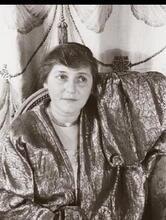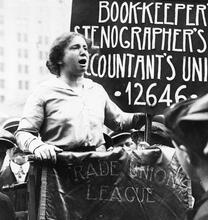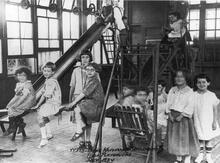Irene Lewisohn
Irene Lewsohn co-founded the Neighborhood Playhouse, known for producing experimental plays by writers such as James Joyce and Sholem Asch. The child of a wealthy industrialist family, Lewisohn gave back to the community by teaching theater and dance at the Henry Street Settlement. There, she and her sister organized a theater and dance troupe that became the Neighborhood Players and constructed a playhouse for the troupe in 1915. By 1920 it had become a professional company. When the playhouse closed, Lewisohn co-founded the Neighborhood Playhouse School of Theater. Just as she had used dance, music, and theater to help the poor through the Settlement House, Lewisohn volunteered her efforts towards the Stage Door Canteen and the Club for Merchant Seamen during World War II to entertain the troops.
Irene Lewisohn was a German Jewish philanthropist whose devotion to the arts led to the formation of two important New York City cultural institutions, the Neighborhood Playhouse and the Museum of Costume Art (now part of the Metropolitan Museum of Art). Her involvement in these and other social and philanthropic activities make her an important figure in New York’s cultural history.
Early Life and Family
Irene Lewisohn was born in New York City on September 5, 1892, to Leonard and Rosalie (Jacobs) Lewisohn. She was the fifth daughter and the youngest of ten children. Lewisohn’s mother came from a wealthy German Jewish New York banking family, while her father, a native of Hamburg, Germany, worked in his family’s export business. The Lewisohns were rich industrialists, and Leonard Lewisohn and his brother Adolph were the principal founders of the American Smelting and Refining Company and the Amalgamated Copper Company. Irene Lewisohn’s mother died in 1900, and her father died two years later.
Lewisohn was educated at the Finch School in New York, where she studied theater and dance. She also studied independently with many actors and dancers, including Yvette Guilbert. Lewisohn’s love for the arts was balanced by a strong inclination toward social work. Her father had been a longtime supporter of the Henry Street Settlement in New York City, and Lewisohn soon became a teacher, club leader, and vocational counselor at Henry Street. She was frequently associated with Lillian Wald, founder and head of the settlement house. Lewisohn and her sister Alice taught acting and dancing at the settlement house, staged amateur productions, and organized a company of “Festival Dancers.” In 1912, the dancers called themselves the Neighborhood Players, and in 1915 they moved into the Neighborhood Playhouse, constructed by Irene and Alice Lewisohn.
The Neighborhood Playhouse
The Neighborhood Playhouse eventually broke away from the Henry Street Settlement as an independent theater, and by 1920, it housed a professional company of actors and dancers. The playhouse became famous for producing plays by experimental and esoteric writers such as James Joyce and Sholem Asch. It also produced a number of plays that reflected the various ethnic backgrounds of people who lived in the area. Three of the Neighborhood Playhouse’s best-known productions were The Little Clay Cart (1924), a Hindu drama; The Dybbuk (1925), a classic Yiddish folk play; and Walt Whitman’s Salut Au Monde (1900). The Neighborhood Playhouse closed in May 1927. In 1928, Lewisohn collaborated with Rita Wallach Morgenthau in founding the Neighborhood Playhouse School of the Theatre. At the school, she conceived and planned “orchestral dramas” where pantomime and dance were used as accompaniment to a full orchestra. The Manhattan Opera House produced the first of these dramas in May 1928.
Although Lewisohn was shy, people who knew her through her work in the theater marveled at her artistic vision and intense dedication. Lewisohn moved away from dance in the 1930s and devoted herself to the Museum of Costume Art. She was also active in a number of social welfare and occupational guidance groups, including the Spanish Welfare Committee for the Loyalist cause during the Spanish Civil War. During World War II, Lewisohn was active in entertaining servicemen in the American Theatre Group’s Stage Door Canteen and the Club for Merchant Seamen.
Legacy
Lewisohn did not affiliate with any Jewish organizations. Jewishness did, however, play a role in her work in the theater. Lewisohn gave voice to people of many cultural, ethnic, and religious groups and embraced ethnic themes in her productions, including those about Eastern European Jews. By incorporating the songs, dances, costumes, and ceremonies of various cultures in her work, she sought to inculcate a general sense of ethnic pride and diversity. Lewisohn died on April 4, 1944, of lung cancer at Doctors’ Hospital in New York.
AJYB 46:341.
“Irene Lewisohn, Welfare Aide, Dies.” NYTimes, April 5, 1944, 19:3.
NAW.






